Analyzing Uber's Real-Time Information Flow in Australian Transport
VerifiedAdded on 2020/02/19
|45
|9831
|85
Report
AI Summary
This report critically investigates the use of real-time information flow by Uber in the Australian taxi industry. It examines how Uber leverages technology, particularly mobile applications, to provide services and gain a competitive advantage. The study explores the background of the Australian taxi industry, the problem of delayed cab arrival times, and the research questions and objectives. A literature review covers topics such as the potential for growth, information efficiencies, regulatory frameworks, and public safety. The research methodology includes a secondary analysis using data from books, journals, and articles. The findings indicate Uber's successful entry into the Australian market through the use of GSM and GPS technology and its ability to meet growing demands. The report concludes with recommendations for future strategies based on the analysis of Uber's real-time information use.
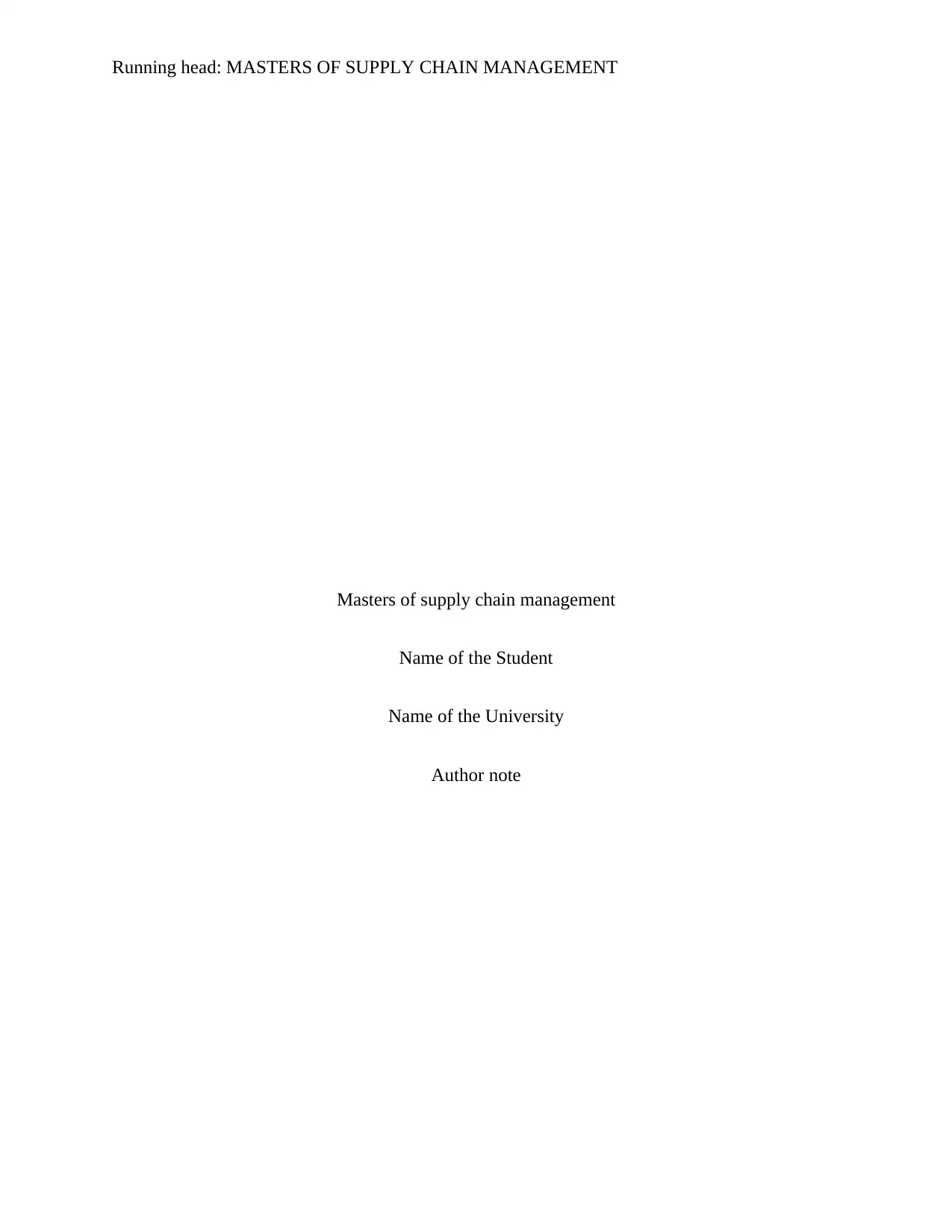
Running head: MASTERS OF SUPPLY CHAIN MANAGEMENT
Masters of supply chain management
Name of the Student
Name of the University
Author note
Masters of supply chain management
Name of the Student
Name of the University
Author note
Paraphrase This Document
Need a fresh take? Get an instant paraphrase of this document with our AI Paraphraser
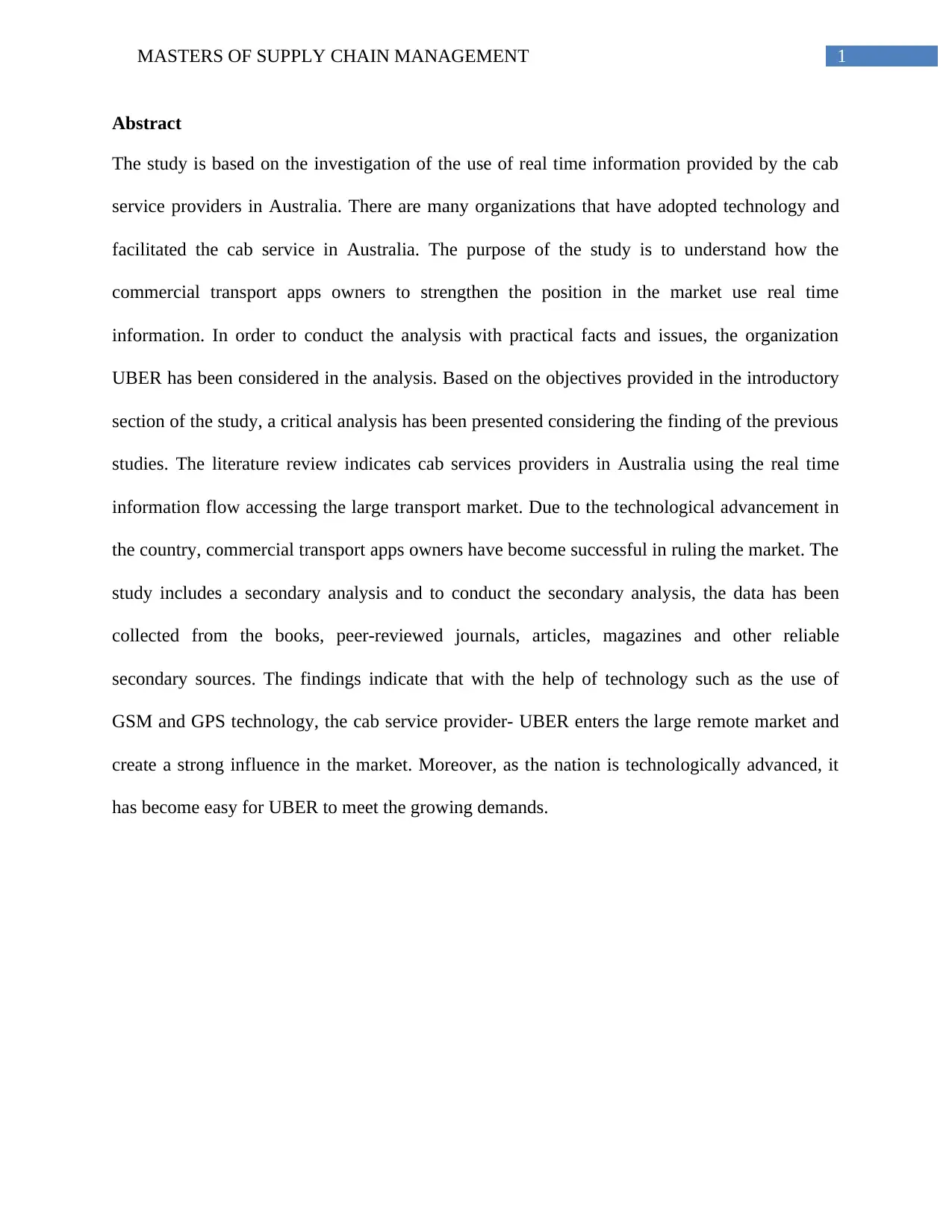
1MASTERS OF SUPPLY CHAIN MANAGEMENT
Abstract
The study is based on the investigation of the use of real time information provided by the cab
service providers in Australia. There are many organizations that have adopted technology and
facilitated the cab service in Australia. The purpose of the study is to understand how the
commercial transport apps owners to strengthen the position in the market use real time
information. In order to conduct the analysis with practical facts and issues, the organization
UBER has been considered in the analysis. Based on the objectives provided in the introductory
section of the study, a critical analysis has been presented considering the finding of the previous
studies. The literature review indicates cab services providers in Australia using the real time
information flow accessing the large transport market. Due to the technological advancement in
the country, commercial transport apps owners have become successful in ruling the market. The
study includes a secondary analysis and to conduct the secondary analysis, the data has been
collected from the books, peer-reviewed journals, articles, magazines and other reliable
secondary sources. The findings indicate that with the help of technology such as the use of
GSM and GPS technology, the cab service provider- UBER enters the large remote market and
create a strong influence in the market. Moreover, as the nation is technologically advanced, it
has become easy for UBER to meet the growing demands.
Abstract
The study is based on the investigation of the use of real time information provided by the cab
service providers in Australia. There are many organizations that have adopted technology and
facilitated the cab service in Australia. The purpose of the study is to understand how the
commercial transport apps owners to strengthen the position in the market use real time
information. In order to conduct the analysis with practical facts and issues, the organization
UBER has been considered in the analysis. Based on the objectives provided in the introductory
section of the study, a critical analysis has been presented considering the finding of the previous
studies. The literature review indicates cab services providers in Australia using the real time
information flow accessing the large transport market. Due to the technological advancement in
the country, commercial transport apps owners have become successful in ruling the market. The
study includes a secondary analysis and to conduct the secondary analysis, the data has been
collected from the books, peer-reviewed journals, articles, magazines and other reliable
secondary sources. The findings indicate that with the help of technology such as the use of
GSM and GPS technology, the cab service provider- UBER enters the large remote market and
create a strong influence in the market. Moreover, as the nation is technologically advanced, it
has become easy for UBER to meet the growing demands.
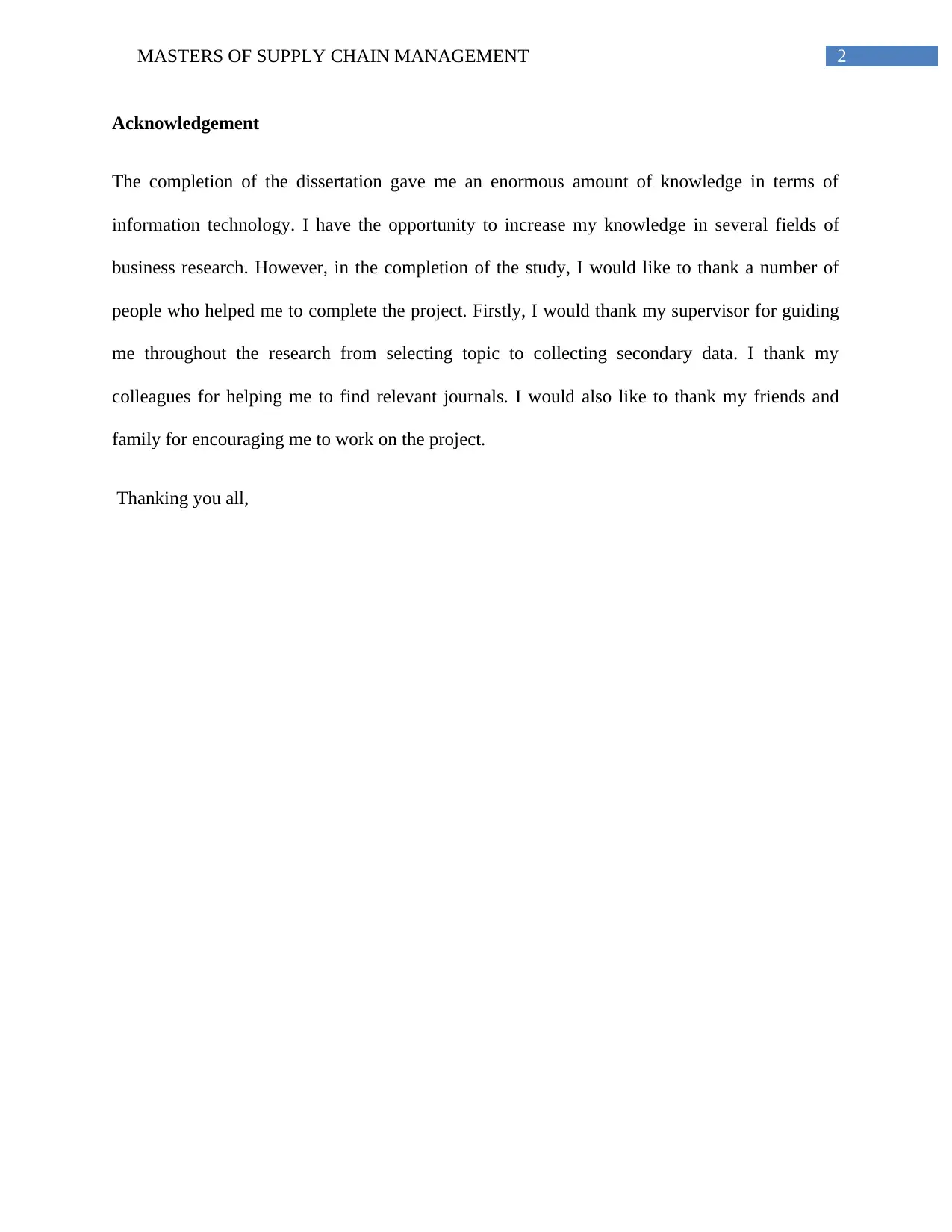
2MASTERS OF SUPPLY CHAIN MANAGEMENT
Acknowledgement
The completion of the dissertation gave me an enormous amount of knowledge in terms of
information technology. I have the opportunity to increase my knowledge in several fields of
business research. However, in the completion of the study, I would like to thank a number of
people who helped me to complete the project. Firstly, I would thank my supervisor for guiding
me throughout the research from selecting topic to collecting secondary data. I thank my
colleagues for helping me to find relevant journals. I would also like to thank my friends and
family for encouraging me to work on the project.
Thanking you all,
Acknowledgement
The completion of the dissertation gave me an enormous amount of knowledge in terms of
information technology. I have the opportunity to increase my knowledge in several fields of
business research. However, in the completion of the study, I would like to thank a number of
people who helped me to complete the project. Firstly, I would thank my supervisor for guiding
me throughout the research from selecting topic to collecting secondary data. I thank my
colleagues for helping me to find relevant journals. I would also like to thank my friends and
family for encouraging me to work on the project.
Thanking you all,
⊘ This is a preview!⊘
Do you want full access?
Subscribe today to unlock all pages.

Trusted by 1+ million students worldwide
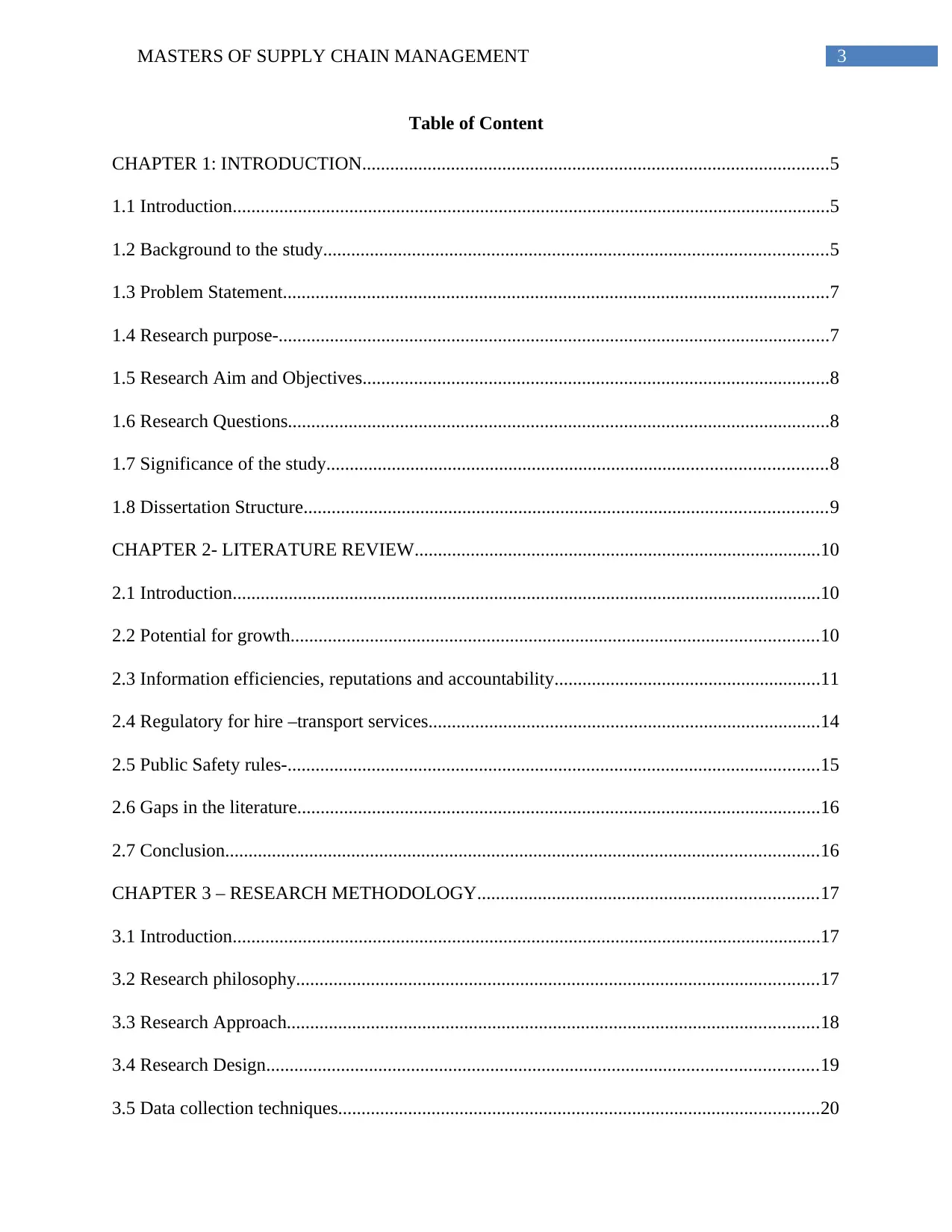
3MASTERS OF SUPPLY CHAIN MANAGEMENT
Table of Content
CHAPTER 1: INTRODUCTION....................................................................................................5
1.1 Introduction................................................................................................................................5
1.2 Background to the study............................................................................................................5
1.3 Problem Statement.....................................................................................................................7
1.4 Research purpose-......................................................................................................................7
1.5 Research Aim and Objectives....................................................................................................8
1.6 Research Questions....................................................................................................................8
1.7 Significance of the study...........................................................................................................8
1.8 Dissertation Structure................................................................................................................9
CHAPTER 2- LITERATURE REVIEW.......................................................................................10
2.1 Introduction..............................................................................................................................10
2.2 Potential for growth.................................................................................................................10
2.3 Information efficiencies, reputations and accountability.........................................................11
2.4 Regulatory for hire –transport services....................................................................................14
2.5 Public Safety rules-..................................................................................................................15
2.6 Gaps in the literature................................................................................................................16
2.7 Conclusion...............................................................................................................................16
CHAPTER 3 – RESEARCH METHODOLOGY.........................................................................17
3.1 Introduction..............................................................................................................................17
3.2 Research philosophy................................................................................................................17
3.3 Research Approach..................................................................................................................18
3.4 Research Design......................................................................................................................19
3.5 Data collection techniques.......................................................................................................20
Table of Content
CHAPTER 1: INTRODUCTION....................................................................................................5
1.1 Introduction................................................................................................................................5
1.2 Background to the study............................................................................................................5
1.3 Problem Statement.....................................................................................................................7
1.4 Research purpose-......................................................................................................................7
1.5 Research Aim and Objectives....................................................................................................8
1.6 Research Questions....................................................................................................................8
1.7 Significance of the study...........................................................................................................8
1.8 Dissertation Structure................................................................................................................9
CHAPTER 2- LITERATURE REVIEW.......................................................................................10
2.1 Introduction..............................................................................................................................10
2.2 Potential for growth.................................................................................................................10
2.3 Information efficiencies, reputations and accountability.........................................................11
2.4 Regulatory for hire –transport services....................................................................................14
2.5 Public Safety rules-..................................................................................................................15
2.6 Gaps in the literature................................................................................................................16
2.7 Conclusion...............................................................................................................................16
CHAPTER 3 – RESEARCH METHODOLOGY.........................................................................17
3.1 Introduction..............................................................................................................................17
3.2 Research philosophy................................................................................................................17
3.3 Research Approach..................................................................................................................18
3.4 Research Design......................................................................................................................19
3.5 Data collection techniques.......................................................................................................20
Paraphrase This Document
Need a fresh take? Get an instant paraphrase of this document with our AI Paraphraser
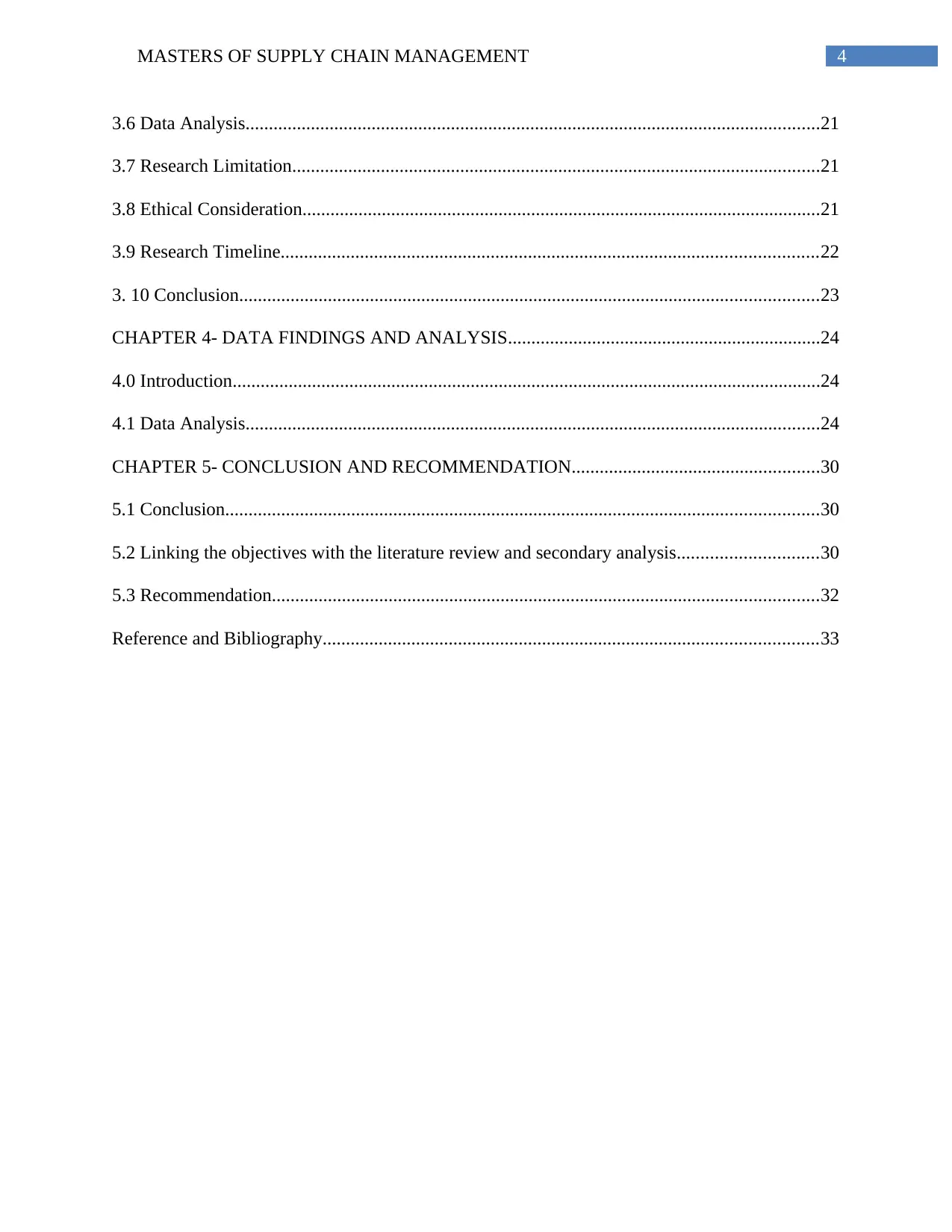
4MASTERS OF SUPPLY CHAIN MANAGEMENT
3.6 Data Analysis...........................................................................................................................21
3.7 Research Limitation.................................................................................................................21
3.8 Ethical Consideration...............................................................................................................21
3.9 Research Timeline...................................................................................................................22
3. 10 Conclusion............................................................................................................................23
CHAPTER 4- DATA FINDINGS AND ANALYSIS...................................................................24
4.0 Introduction..............................................................................................................................24
4.1 Data Analysis...........................................................................................................................24
CHAPTER 5- CONCLUSION AND RECOMMENDATION.....................................................30
5.1 Conclusion...............................................................................................................................30
5.2 Linking the objectives with the literature review and secondary analysis..............................30
5.3 Recommendation.....................................................................................................................32
Reference and Bibliography..........................................................................................................33
3.6 Data Analysis...........................................................................................................................21
3.7 Research Limitation.................................................................................................................21
3.8 Ethical Consideration...............................................................................................................21
3.9 Research Timeline...................................................................................................................22
3. 10 Conclusion............................................................................................................................23
CHAPTER 4- DATA FINDINGS AND ANALYSIS...................................................................24
4.0 Introduction..............................................................................................................................24
4.1 Data Analysis...........................................................................................................................24
CHAPTER 5- CONCLUSION AND RECOMMENDATION.....................................................30
5.1 Conclusion...............................................................................................................................30
5.2 Linking the objectives with the literature review and secondary analysis..............................30
5.3 Recommendation.....................................................................................................................32
Reference and Bibliography..........................................................................................................33
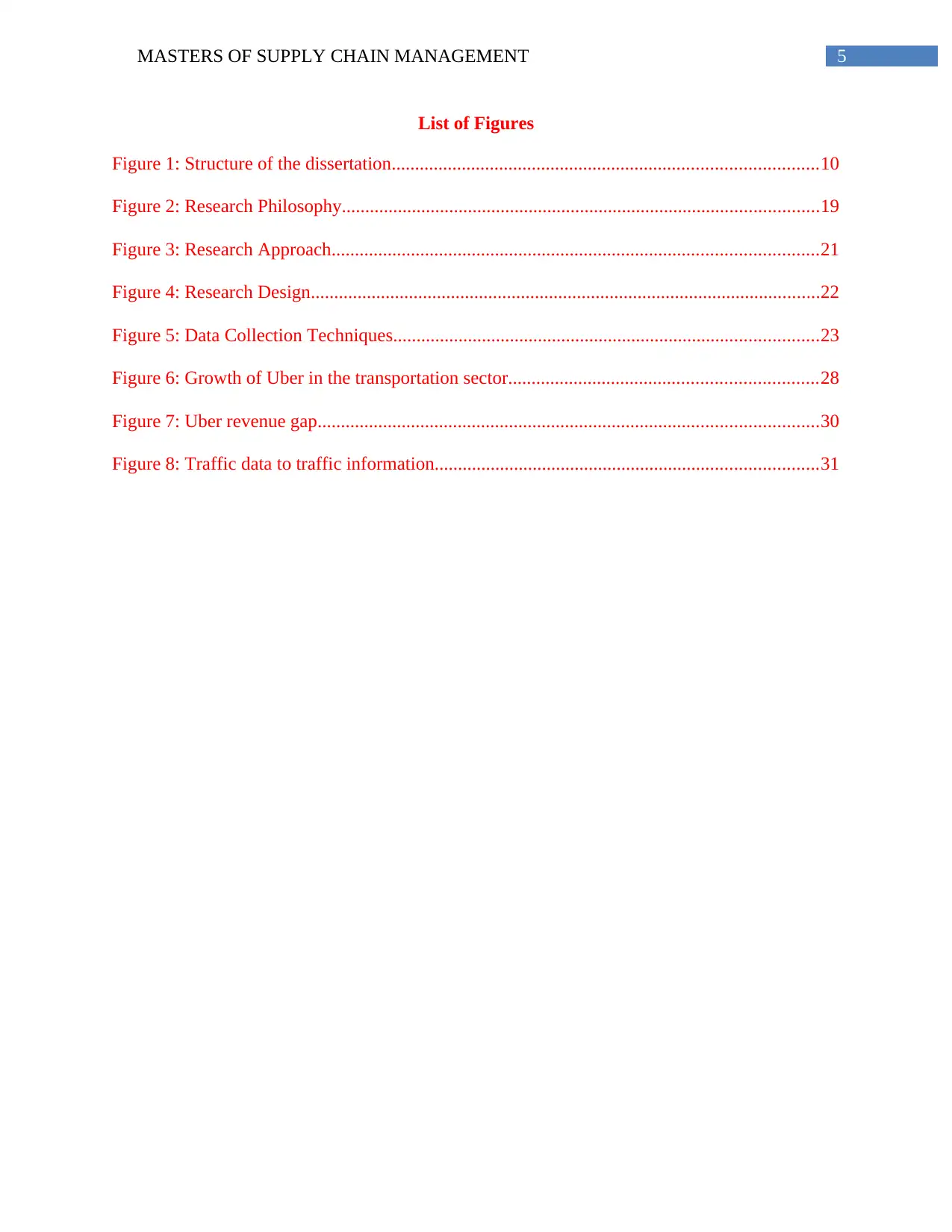
5MASTERS OF SUPPLY CHAIN MANAGEMENT
List of Figures
Figure 1: Structure of the dissertation...........................................................................................10
Figure 2: Research Philosophy......................................................................................................19
Figure 3: Research Approach........................................................................................................21
Figure 4: Research Design.............................................................................................................22
Figure 5: Data Collection Techniques...........................................................................................23
Figure 6: Growth of Uber in the transportation sector..................................................................28
Figure 7: Uber revenue gap...........................................................................................................30
Figure 8: Traffic data to traffic information..................................................................................31
List of Figures
Figure 1: Structure of the dissertation...........................................................................................10
Figure 2: Research Philosophy......................................................................................................19
Figure 3: Research Approach........................................................................................................21
Figure 4: Research Design.............................................................................................................22
Figure 5: Data Collection Techniques...........................................................................................23
Figure 6: Growth of Uber in the transportation sector..................................................................28
Figure 7: Uber revenue gap...........................................................................................................30
Figure 8: Traffic data to traffic information..................................................................................31
⊘ This is a preview!⊘
Do you want full access?
Subscribe today to unlock all pages.

Trusted by 1+ million students worldwide
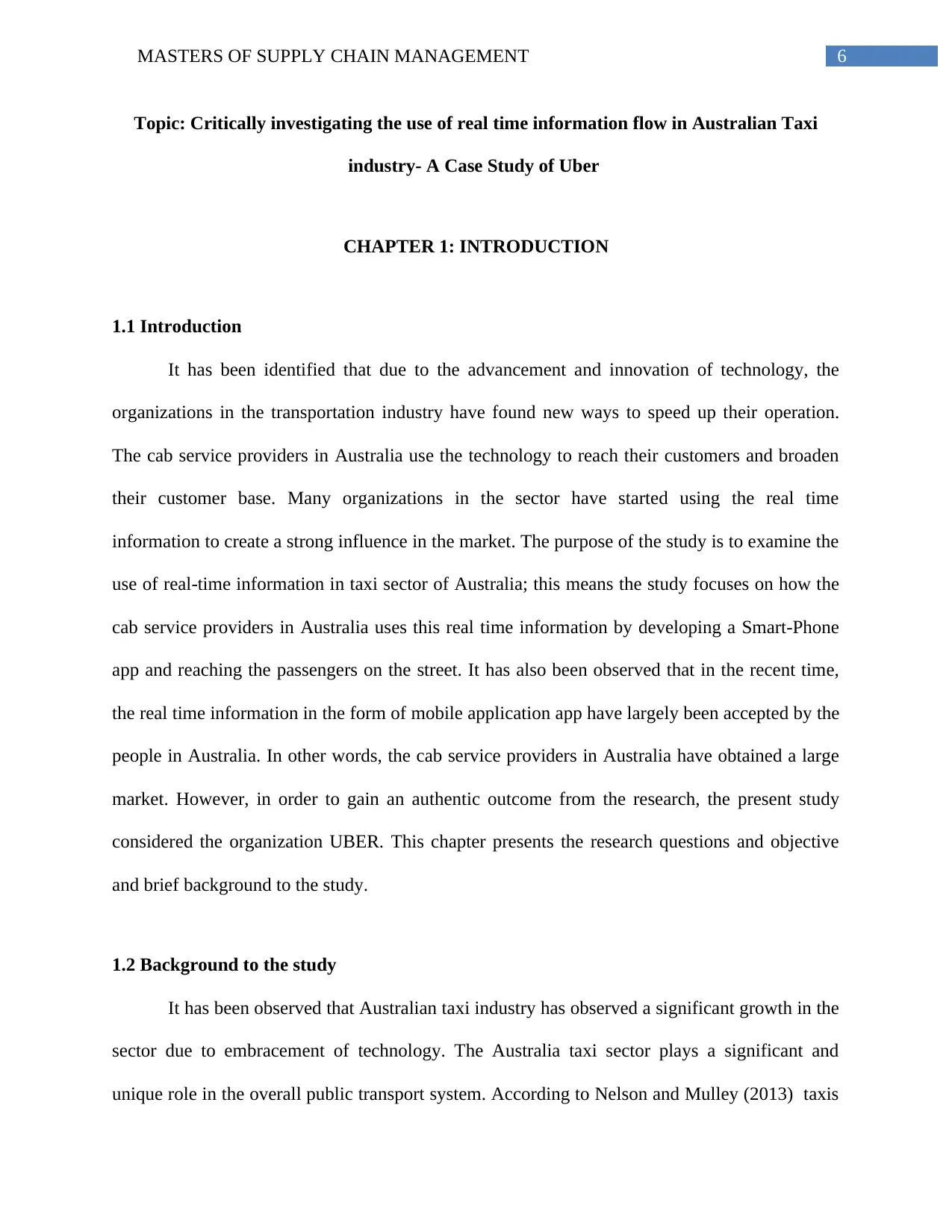
6MASTERS OF SUPPLY CHAIN MANAGEMENT
Topic: Critically investigating the use of real time information flow in Australian Taxi
industry- A Case Study of Uber
CHAPTER 1: INTRODUCTION
1.1 Introduction
It has been identified that due to the advancement and innovation of technology, the
organizations in the transportation industry have found new ways to speed up their operation.
The cab service providers in Australia use the technology to reach their customers and broaden
their customer base. Many organizations in the sector have started using the real time
information to create a strong influence in the market. The purpose of the study is to examine the
use of real-time information in taxi sector of Australia; this means the study focuses on how the
cab service providers in Australia uses this real time information by developing a Smart-Phone
app and reaching the passengers on the street. It has also been observed that in the recent time,
the real time information in the form of mobile application app have largely been accepted by the
people in Australia. In other words, the cab service providers in Australia have obtained a large
market. However, in order to gain an authentic outcome from the research, the present study
considered the organization UBER. This chapter presents the research questions and objective
and brief background to the study.
1.2 Background to the study
It has been observed that Australian taxi industry has observed a significant growth in the
sector due to embracement of technology. The Australia taxi sector plays a significant and
unique role in the overall public transport system. According to Nelson and Mulley (2013) taxis
Topic: Critically investigating the use of real time information flow in Australian Taxi
industry- A Case Study of Uber
CHAPTER 1: INTRODUCTION
1.1 Introduction
It has been identified that due to the advancement and innovation of technology, the
organizations in the transportation industry have found new ways to speed up their operation.
The cab service providers in Australia use the technology to reach their customers and broaden
their customer base. Many organizations in the sector have started using the real time
information to create a strong influence in the market. The purpose of the study is to examine the
use of real-time information in taxi sector of Australia; this means the study focuses on how the
cab service providers in Australia uses this real time information by developing a Smart-Phone
app and reaching the passengers on the street. It has also been observed that in the recent time,
the real time information in the form of mobile application app have largely been accepted by the
people in Australia. In other words, the cab service providers in Australia have obtained a large
market. However, in order to gain an authentic outcome from the research, the present study
considered the organization UBER. This chapter presents the research questions and objective
and brief background to the study.
1.2 Background to the study
It has been observed that Australian taxi industry has observed a significant growth in the
sector due to embracement of technology. The Australia taxi sector plays a significant and
unique role in the overall public transport system. According to Nelson and Mulley (2013) taxis
Paraphrase This Document
Need a fresh take? Get an instant paraphrase of this document with our AI Paraphraser

7MASTERS OF SUPPLY CHAIN MANAGEMENT
operate on demand, 24 hours a day, 365 days a year, providing door to door services. Each year
in Australia almost 20,000+ taxis move more than 350 million passengers and provide gainful
work as well as the business opportunities for more than 750000 people directly within the
sector. Almost 12% of the taxi fleet is wheelchair accessible. As put forward by Page (2013),
taxis plays a significant role in servicing the needs of the community in general and such practice
has now been effective as the organizations in the sector have using the digital mode of
transportation where they can track the information. Especially, taxis play a mandatory role in
the servicing the requirement of the community generally and key sections of the community in
particular.
The organizations in the transport sector have now been able to fulfill these needs more
effectively due to the advancement in the technology. As the development of this sector, the
ridesharing is a relatively a new class of point-to-point transport. Especially, businesses like
Uber, and its competitors include tend to operate in dynamic environment through which the
drivers offer their own vehicle as well as matched with the passengers who seek to reach a
particular destination (Hughes and MacKenzie 2016). It remains as the distinct point from the
traditional taxi service in that ridesharing services only the collect passengers who usually book
through their platforms. Another potential impact of the entry of real-time information flow to
the Australian market is the rethink by the governments around the regulatory reform of the taxi
sector. As put forward by Firnkorn and Müller (2011), the regulatory reform to enhance the
consequence in this sector has been urged by a number of significant reviews. Nonetheless, it has
also observed that as the cab service providers who use the real time information flow to reach
the customers, have been able to gain the control over the large market and as the consequence,
operate on demand, 24 hours a day, 365 days a year, providing door to door services. Each year
in Australia almost 20,000+ taxis move more than 350 million passengers and provide gainful
work as well as the business opportunities for more than 750000 people directly within the
sector. Almost 12% of the taxi fleet is wheelchair accessible. As put forward by Page (2013),
taxis plays a significant role in servicing the needs of the community in general and such practice
has now been effective as the organizations in the sector have using the digital mode of
transportation where they can track the information. Especially, taxis play a mandatory role in
the servicing the requirement of the community generally and key sections of the community in
particular.
The organizations in the transport sector have now been able to fulfill these needs more
effectively due to the advancement in the technology. As the development of this sector, the
ridesharing is a relatively a new class of point-to-point transport. Especially, businesses like
Uber, and its competitors include tend to operate in dynamic environment through which the
drivers offer their own vehicle as well as matched with the passengers who seek to reach a
particular destination (Hughes and MacKenzie 2016). It remains as the distinct point from the
traditional taxi service in that ridesharing services only the collect passengers who usually book
through their platforms. Another potential impact of the entry of real-time information flow to
the Australian market is the rethink by the governments around the regulatory reform of the taxi
sector. As put forward by Firnkorn and Müller (2011), the regulatory reform to enhance the
consequence in this sector has been urged by a number of significant reviews. Nonetheless, it has
also observed that as the cab service providers who use the real time information flow to reach
the customers, have been able to gain the control over the large market and as the consequence,
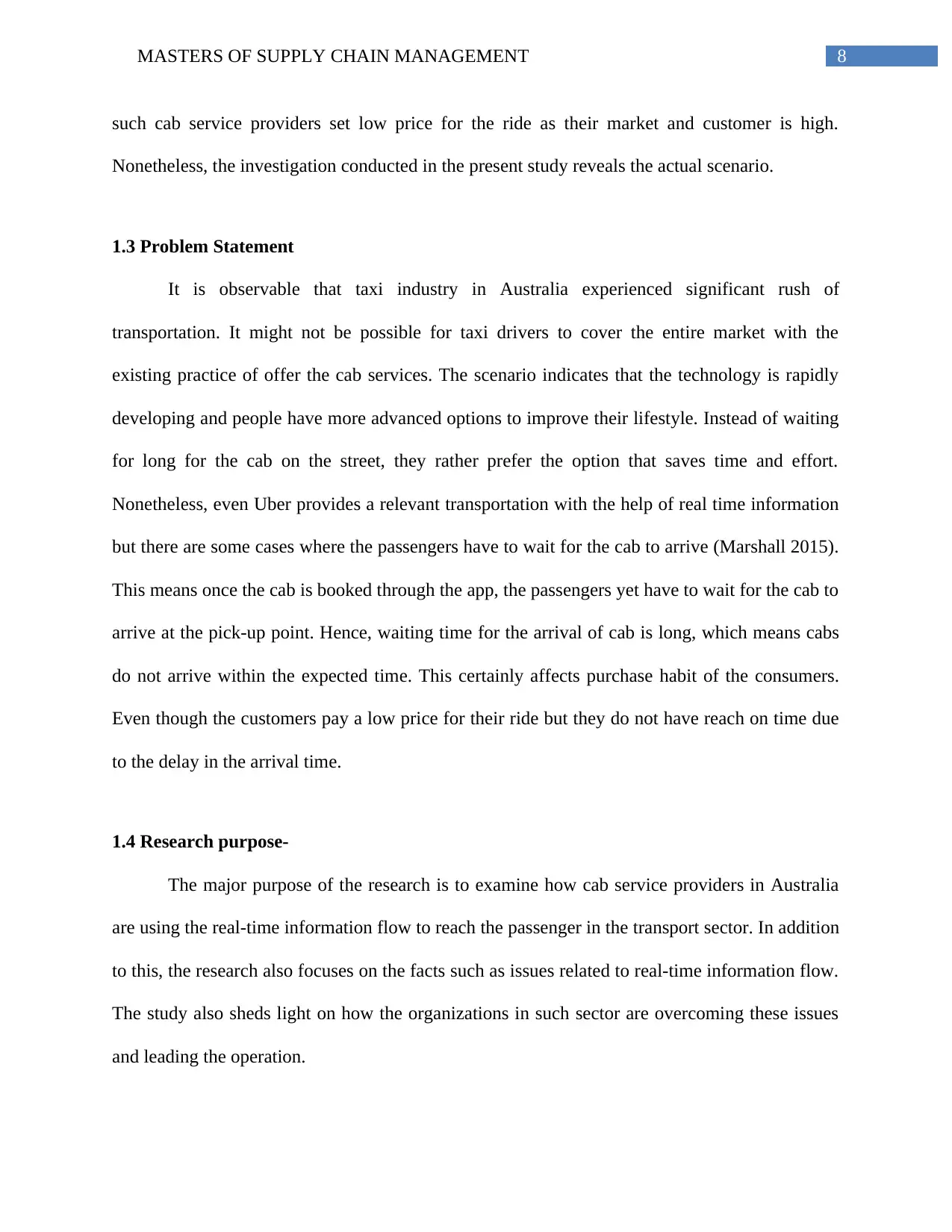
8MASTERS OF SUPPLY CHAIN MANAGEMENT
such cab service providers set low price for the ride as their market and customer is high.
Nonetheless, the investigation conducted in the present study reveals the actual scenario.
1.3 Problem Statement
It is observable that taxi industry in Australia experienced significant rush of
transportation. It might not be possible for taxi drivers to cover the entire market with the
existing practice of offer the cab services. The scenario indicates that the technology is rapidly
developing and people have more advanced options to improve their lifestyle. Instead of waiting
for long for the cab on the street, they rather prefer the option that saves time and effort.
Nonetheless, even Uber provides a relevant transportation with the help of real time information
but there are some cases where the passengers have to wait for the cab to arrive (Marshall 2015).
This means once the cab is booked through the app, the passengers yet have to wait for the cab to
arrive at the pick-up point. Hence, waiting time for the arrival of cab is long, which means cabs
do not arrive within the expected time. This certainly affects purchase habit of the consumers.
Even though the customers pay a low price for their ride but they do not have reach on time due
to the delay in the arrival time.
1.4 Research purpose-
The major purpose of the research is to examine how cab service providers in Australia
are using the real-time information flow to reach the passenger in the transport sector. In addition
to this, the research also focuses on the facts such as issues related to real-time information flow.
The study also sheds light on how the organizations in such sector are overcoming these issues
and leading the operation.
such cab service providers set low price for the ride as their market and customer is high.
Nonetheless, the investigation conducted in the present study reveals the actual scenario.
1.3 Problem Statement
It is observable that taxi industry in Australia experienced significant rush of
transportation. It might not be possible for taxi drivers to cover the entire market with the
existing practice of offer the cab services. The scenario indicates that the technology is rapidly
developing and people have more advanced options to improve their lifestyle. Instead of waiting
for long for the cab on the street, they rather prefer the option that saves time and effort.
Nonetheless, even Uber provides a relevant transportation with the help of real time information
but there are some cases where the passengers have to wait for the cab to arrive (Marshall 2015).
This means once the cab is booked through the app, the passengers yet have to wait for the cab to
arrive at the pick-up point. Hence, waiting time for the arrival of cab is long, which means cabs
do not arrive within the expected time. This certainly affects purchase habit of the consumers.
Even though the customers pay a low price for their ride but they do not have reach on time due
to the delay in the arrival time.
1.4 Research purpose-
The major purpose of the research is to examine how cab service providers in Australia
are using the real-time information flow to reach the passenger in the transport sector. In addition
to this, the research also focuses on the facts such as issues related to real-time information flow.
The study also sheds light on how the organizations in such sector are overcoming these issues
and leading the operation.
⊘ This is a preview!⊘
Do you want full access?
Subscribe today to unlock all pages.

Trusted by 1+ million students worldwide
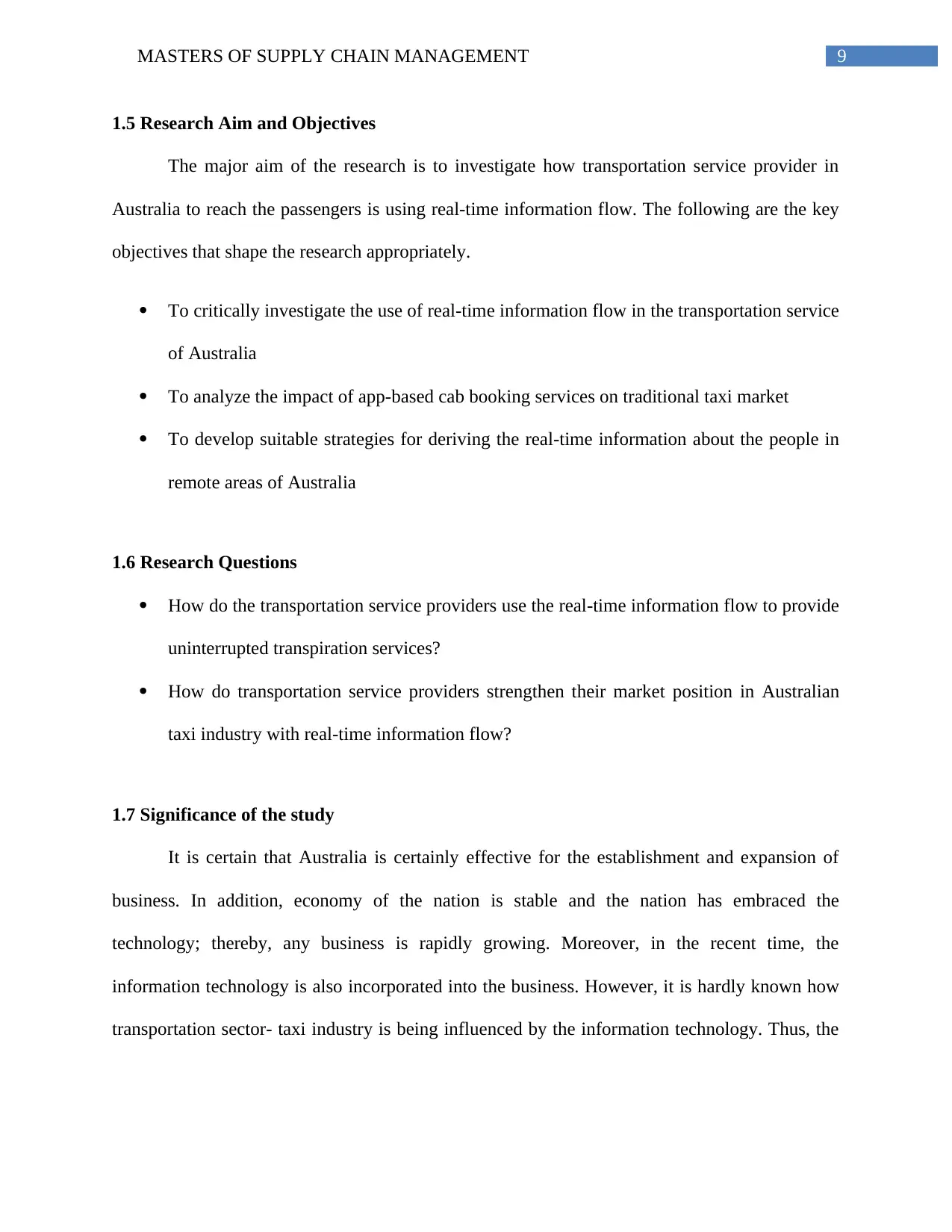
9MASTERS OF SUPPLY CHAIN MANAGEMENT
1.5 Research Aim and Objectives
The major aim of the research is to investigate how transportation service provider in
Australia to reach the passengers is using real-time information flow. The following are the key
objectives that shape the research appropriately.
To critically investigate the use of real-time information flow in the transportation service
of Australia
To analyze the impact of app-based cab booking services on traditional taxi market
To develop suitable strategies for deriving the real-time information about the people in
remote areas of Australia
1.6 Research Questions
How do the transportation service providers use the real-time information flow to provide
uninterrupted transpiration services?
How do transportation service providers strengthen their market position in Australian
taxi industry with real-time information flow?
1.7 Significance of the study
It is certain that Australia is certainly effective for the establishment and expansion of
business. In addition, economy of the nation is stable and the nation has embraced the
technology; thereby, any business is rapidly growing. Moreover, in the recent time, the
information technology is also incorporated into the business. However, it is hardly known how
transportation sector- taxi industry is being influenced by the information technology. Thus, the
1.5 Research Aim and Objectives
The major aim of the research is to investigate how transportation service provider in
Australia to reach the passengers is using real-time information flow. The following are the key
objectives that shape the research appropriately.
To critically investigate the use of real-time information flow in the transportation service
of Australia
To analyze the impact of app-based cab booking services on traditional taxi market
To develop suitable strategies for deriving the real-time information about the people in
remote areas of Australia
1.6 Research Questions
How do the transportation service providers use the real-time information flow to provide
uninterrupted transpiration services?
How do transportation service providers strengthen their market position in Australian
taxi industry with real-time information flow?
1.7 Significance of the study
It is certain that Australia is certainly effective for the establishment and expansion of
business. In addition, economy of the nation is stable and the nation has embraced the
technology; thereby, any business is rapidly growing. Moreover, in the recent time, the
information technology is also incorporated into the business. However, it is hardly known how
transportation sector- taxi industry is being influenced by the information technology. Thus, the
Paraphrase This Document
Need a fresh take? Get an instant paraphrase of this document with our AI Paraphraser
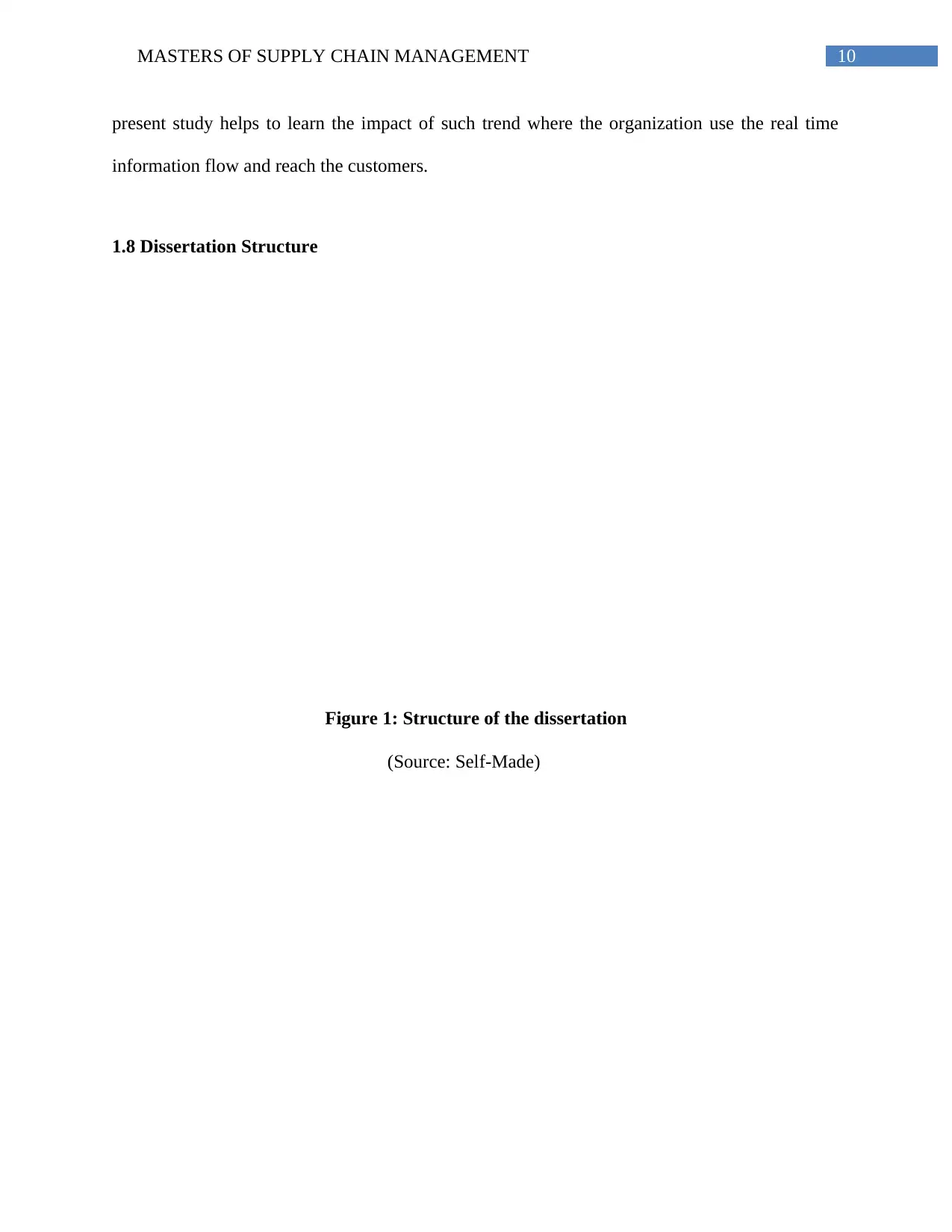
10MASTERS OF SUPPLY CHAIN MANAGEMENT
present study helps to learn the impact of such trend where the organization use the real time
information flow and reach the customers.
1.8 Dissertation Structure
Figure 1: Structure of the dissertation
(Source: Self-Made)
present study helps to learn the impact of such trend where the organization use the real time
information flow and reach the customers.
1.8 Dissertation Structure
Figure 1: Structure of the dissertation
(Source: Self-Made)
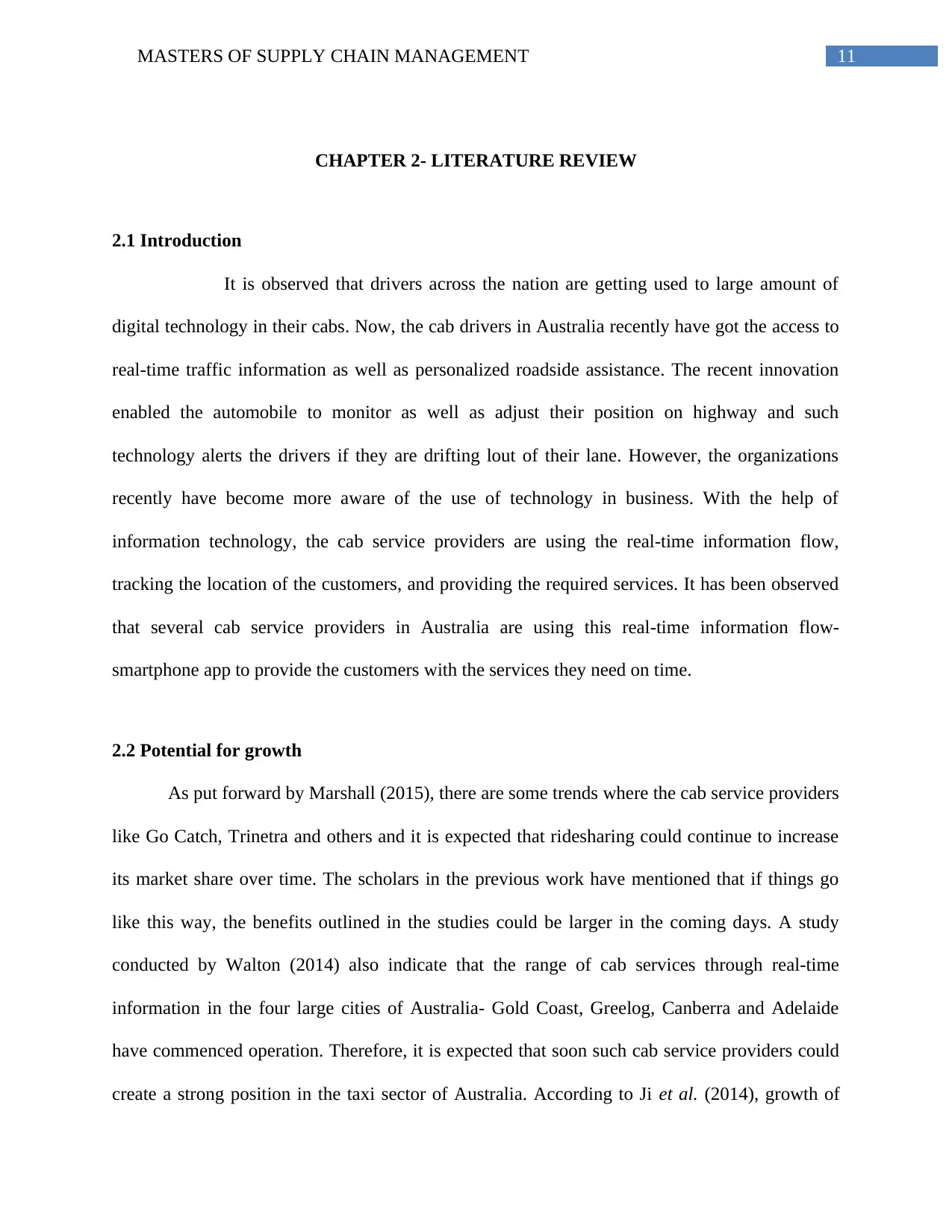
11MASTERS OF SUPPLY CHAIN MANAGEMENT
CHAPTER 2- LITERATURE REVIEW
2.1 Introduction
It is observed that drivers across the nation are getting used to large amount of
digital technology in their cabs. Now, the cab drivers in Australia recently have got the access to
real-time traffic information as well as personalized roadside assistance. The recent innovation
enabled the automobile to monitor as well as adjust their position on highway and such
technology alerts the drivers if they are drifting lout of their lane. However, the organizations
recently have become more aware of the use of technology in business. With the help of
information technology, the cab service providers are using the real-time information flow,
tracking the location of the customers, and providing the required services. It has been observed
that several cab service providers in Australia are using this real-time information flow-
smartphone app to provide the customers with the services they need on time.
2.2 Potential for growth
As put forward by Marshall (2015), there are some trends where the cab service providers
like Go Catch, Trinetra and others and it is expected that ridesharing could continue to increase
its market share over time. The scholars in the previous work have mentioned that if things go
like this way, the benefits outlined in the studies could be larger in the coming days. A study
conducted by Walton (2014) also indicate that the range of cab services through real-time
information in the four large cities of Australia- Gold Coast, Greelog, Canberra and Adelaide
have commenced operation. Therefore, it is expected that soon such cab service providers could
create a strong position in the taxi sector of Australia. According to Ji et al. (2014), growth of
CHAPTER 2- LITERATURE REVIEW
2.1 Introduction
It is observed that drivers across the nation are getting used to large amount of
digital technology in their cabs. Now, the cab drivers in Australia recently have got the access to
real-time traffic information as well as personalized roadside assistance. The recent innovation
enabled the automobile to monitor as well as adjust their position on highway and such
technology alerts the drivers if they are drifting lout of their lane. However, the organizations
recently have become more aware of the use of technology in business. With the help of
information technology, the cab service providers are using the real-time information flow,
tracking the location of the customers, and providing the required services. It has been observed
that several cab service providers in Australia are using this real-time information flow-
smartphone app to provide the customers with the services they need on time.
2.2 Potential for growth
As put forward by Marshall (2015), there are some trends where the cab service providers
like Go Catch, Trinetra and others and it is expected that ridesharing could continue to increase
its market share over time. The scholars in the previous work have mentioned that if things go
like this way, the benefits outlined in the studies could be larger in the coming days. A study
conducted by Walton (2014) also indicate that the range of cab services through real-time
information in the four large cities of Australia- Gold Coast, Greelog, Canberra and Adelaide
have commenced operation. Therefore, it is expected that soon such cab service providers could
create a strong position in the taxi sector of Australia. According to Ji et al. (2014), growth of
⊘ This is a preview!⊘
Do you want full access?
Subscribe today to unlock all pages.

Trusted by 1+ million students worldwide
1 out of 45
Related Documents
Your All-in-One AI-Powered Toolkit for Academic Success.
+13062052269
info@desklib.com
Available 24*7 on WhatsApp / Email
![[object Object]](/_next/static/media/star-bottom.7253800d.svg)
Unlock your academic potential
Copyright © 2020–2025 A2Z Services. All Rights Reserved. Developed and managed by ZUCOL.





